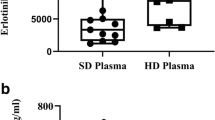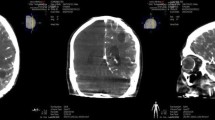Abstract
Platinum (Pt) levels in plasma and cerebrospinal fluid (CSF) in patients with malignant glioma were determined after initiation of selective intraarterial chemotherapy with a combination of VP-16 (etoposide) and CDDP (cisplatin), and were compared with the CSF Pt levels in patients with metastatic brain tumors after intravenous or intracarotid administration of VP-16 and CDDP. CSF Pt levels were also compared for various administration routes, doses, CSF sampling routes and blood–CSF barriers in metastatic brain tumor. Changes in the blood-CSF barrier to CDDP during treatment in a patient with meningeal lymphoma and in a patient recovering from surgical removal of a metastatic brain tumor were also examined by periodic administration of CDDP. All CSF samples were taken through Ommaya reservoirs placed in the anterior horn of the lateral ventricle or the postoperative cavity. The mean peak CSF/plasma total Pt ratio (T/T ratio) and the mean CSF total Pt/plasma ultrafiltrable Pt ratio (T/U ratio) were highest (15.0% and 24.4%, respectively) following selective intraarterial infusion of CDDP in patients with malignant glioma, followed by intravenous infusion in meningeal carcinomatosis (11.5% and 18.9%), intracarotid administration (5.4% and 8.7%) and intravenous infusion (60 mg/m2 2.5% and 100 mg/m2 2.9%; and 60 mg/m2 3.5% and 100 mg/m2 7.7%) in patients with the solid type of metastatic brain tumor. In CSF obtained from the postoperative cavity in cases of metastatic brain tumor, T/T and T/U ratios were extremely high (40.9% and 62.4%). However, the CSF Pt level even after selective intraarterial administration of CDDP in malignant glioma was 0.51–1.64 μg/ml total Pt and 0.43–1.08 μg/ml ultrafiltrable Pt. Even the CSF level obtained from the postoperative cavity was 1.0–4.7 μg/ml total Pt. These low levels of total and ultrafiltrable Pt are considered not to be cytotoxic to disseminated cells in the CSF space and to normal brain cells. As for changes in the blood–CSF barrier, repeated administration of CDDP showed that the rate of entry of Pt into the CSF decreased in parallel with improvements apparent on CT scans in the patient with meningeal lymphoma, and also showed that the blood–CSF barrier to Pt was gradually repaired after the metastatic brain tumor had been removed.
Similar content being viewed by others
Author information
Authors and Affiliations
Additional information
Received: 20 June 1994/Accepted: 14 May 1995
Rights and permissions
About this article
Cite this article
Nakagawa, H., Fujita, T., Kubo, S. et al. Difference in CDDP penetration into CSF between selective intraarterial chemotherapy in patients with malignant glioma and intravenous or intracarotid administration in patients with metastatic brain tumor. Cancer Chemother Pharmacol 37, 317–326 (1996). https://doi.org/10.1007/s002800050391
Issue Date:
DOI: https://doi.org/10.1007/s002800050391




